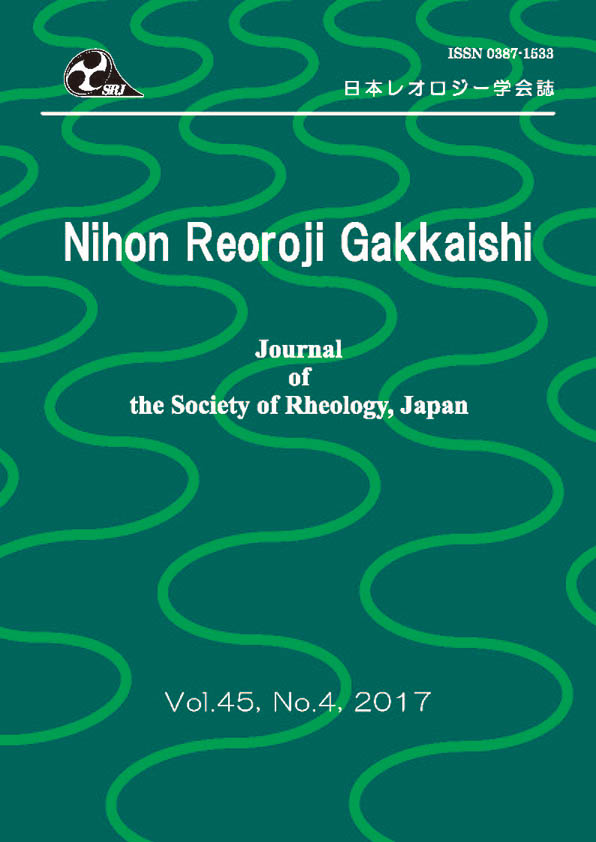
- 1 号 p. 1-
- |<
- <
- 1
- >
- >|
-
Kyeong Jin Kim, Kyung Hyun Ahn原稿種別: Research Paper Encouragement Award Article
2024 年 52 巻 1 号 p. 1-13
発行日: 2024/02/15
公開日: 2024/03/15
ジャーナル フリーThis study investigates the influence of the molecular weight of carboxymethyl cellulose (CMC) on the dispersion characteristics of silicon (Si) particles in Si/CMC model suspensions. The chain length of CMC is systematically adjusted, ranging from approximately 77 kDa to 281 kDa using the ultrasonic degradation method and characterized through the Mark-Houwink relation and gel permeation chromatography. Our findings confirm that decreasing CMC chain length enhances the dispersion of silicon particles by suppressing bridging flocculation, leading to a rapid reduction in the size of silicon agglomerates. The critical molecular weight required to disperse silicon particles with their primary size is found to be 190 kDa. This study highlights the benefits of utilizing low-molecular-weight CMC as a dispersant to effectively improve the dispersion of Si/CMC suspensions. Through a systematic exploration of the agglomeration behavior of silicon particles with varying molecular weight of CMC, valuable insights are provided regarding the optimal molecular weight necessary to mitigate severe agglomeration of silicon particles. We anticipate that this study contributes to the optimization and design of dispersants, thereby enhancing both the dispersion quality and the performance of silicon-containing electrodes.
抄録全体を表示PDF形式でダウンロード (2106K) -
Souta Miyamoto原稿種別: Research Paper Encouragement Award Article
2024 年 52 巻 1 号 p. 15-19
発行日: 2024/02/15
公開日: 2024/03/15
ジャーナル フリーWe briefly review the machine-learning (ML) applications for rheological research, particularly on the multi-scale simulation (MSS) techniques for complex fluid flows. For such simulations, it is essential to accurately model the constitutive relation (i.e., the strain-rate and stress relation) of complex fluids. Several past studies have found that ML applications for modeling the constitutive relation can reasonably accelerate the flow predictions from a microscopically resolved description of complex fluids such as polymers and colloidal suspensions. Nevertheless, even when the proposed regression models are consistent with the physical knowledge, several outstanding questions remain to be answered, for example, how to ensure the robustness of the predictions. This review summarizes the methods to obtain constitutive models using ML techniques and those applications based on molecular and phenomenological knowledge. Furthermore, we provide a perspective on how to develop the ML framework starting from a microscopic description.
抄録全体を表示PDF形式でダウンロード (699K)
-
Yuichi Masubuchi原稿種別: Original Article
2024 年 52 巻 1 号 p. 21-26
発行日: 2024/02/15
公開日: 2024/03/15
ジャーナル フリーBy phantom chain simulations, it has been recently discovered that the fracture characteristics of star polymer networks with different node functionalities and conversion ratios can be described by the cycle rank of the networks [Masubuchi et al., Macromolecules, 56, 9359–9367 (2023)]. However, due to the employed simplifications and idealizations of the examined model networks, the results cannot be cast into realistic systems straightforwardly. For instance, the equimolar reaction was assumed in a limited volume for the binary mixture of star prepolymers. For this issue, the present study investigated the effects of stoichiometry by phantom chain simulations. Examined polymer networks were created from binary mixtures of star prepolymers with various mixing ratios by the end-linking reaction via Brownian dynamics simulations. The networks were stretched with energy minimization until the break. From the mechanical response, strain and stress at break and work for fracture were obtained. These fracture characteristics slightly decrease with increasing the contrast of volume fractions of the binary prepolymer blends when the node functionality is small, and the conversion ratio is large. For the other cases, the stoichiometry does not impact the fracture behavior. The number ratio of broken bonds and the cycle rank exhibit similar stoichiometry dependence. Consequently, the stoichiometry of prepolymer blends does not disturb the previously reported relationships between the fracture characteristics and the cycle rank.
抄録全体を表示PDF形式でダウンロード (1178K) -
Takashi Uneyama原稿種別: Original Article
2024 年 52 巻 1 号 p. 27-35
発行日: 2024/02/15
公開日: 2024/03/15
ジャーナル フリーThe Rouse model with harmonic springs and the Langevin equation (the Langevin-Rouse model) is widely used to describe the linear viscoelasticity of unentangled polymer melts. A similar model, in which the Langevin equation is replaced by discrete local jump dynamics (the jump-Rouse model), is also used to describe the dynamics of some systems such as entangled polymer melts. Intuitively, we expect that the Langevin- and jump-Rouse models give similar linear viscoelastic behaviors. However, the Langevin- and jump-Rouse models are not equivalent, and their linear viscoelastic behaviors can be different. In this work, we compare the shear relaxation moduli of the Langevin- and jump-Rouse model in detail. We develop a jump rate model in which the resampling ratio is tunable. By using this jump rate model, we can smoothly connect the jump-Rouse model and the Langevin-Rouse model. We perform kinetic Monte Carlo simulations to calculate the shear relaxation modulus data of the jump-Rouse model. We compare the simulation results with various numbers of beads and resampling ratios, and show that the shear relaxation moduli of the Langevin- and jump-Rouse models are similar but slightly different. We analyze the short-time relaxation behavior of the jump-Rouse model, and show that the local jumps give a single Maxwell type relaxation in the short-time region.
抄録全体を表示PDF形式でダウンロード (1966K)
-
Katsuyoshi Nishinari, Ke Zhang, Nan Yang, Zhiming Gao, Chaiwut Gamonpi ...原稿種別: Review
2024 年 52 巻 1 号 p. 37-64
発行日: 2024/02/15
公開日: 2024/03/15
ジャーナル フリーPDF形式でダウンロード (7804K)
-
武田 敬子, スクマラン サティシュ, 杉本 昌隆原稿種別: 読者のページ
2024 年 52 巻 1 号 p. 65-66
発行日: 2024/02/15
公開日: 2024/03/15
ジャーナル フリーPDF形式でダウンロード (873K)
-
- 新素材・自己修復・強靭化と最先端評価技術 -片島 拓弥原稿種別: 書評
2024 年 52 巻 1 号 p. 67
発行日: 2024/02/15
公開日: 2024/03/15
ジャーナル フリーPDF形式でダウンロード (571K)
- |<
- <
- 1
- >
- >|